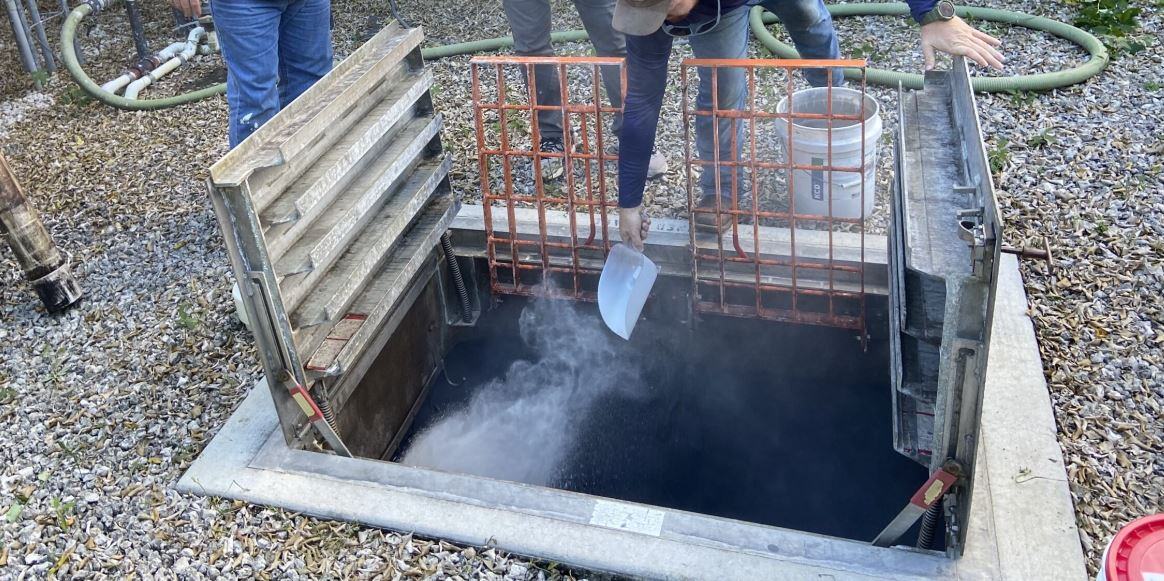- Home
- Supply Insights
- Lift Station Degreasers
Comparing different products used for FOG management and lift station maintenance.
In this article, we’ll explore three different types of degreasers for lift stations, including their pros and cons. Lift stations contain many intricate parts, and degreasers help ensure that fats, oils, and grease (FOG) don’t impact collection system performance while keeping odors to a minimum.
A Wastewater Operator or Collection System Technician regularly visits lift stations for inspection, cleaning and maintenance. In some cases, a lift station might need regular maintenance on a weekly schedule. Regardless of frequency, lift stations need constant maintenance and inspection to ensure proper functionality.
Different Types of Lift Station Degreasers
The most common type of FOG degreaser is an emulsifier. Emulsifiers bond to the grease and “float” it to the top, ensuring the FOG is not getting sucked into the pump and clogging pipes. Products like Kationx™’s KCD™ and KCDX™ are examples of emulsifiers and allow technicians to maintain lift stations easily.
Floating degreasers are also popular and regularly used in lift stations. This product is engineered to stick to the sides of the lift station and prevents new FOG from sticking to the well. Because it floats on top of the wet well, it blocks unpleasant odors from rising through the lift station. Floating degreasers can be a quick and easy solution to odors, but they do not use a biological agent to digest the FOG.
Finally, the last popular type of lift station degreaser is the "set and forget" bio-block. These non-toxic blocks sit at the bottom of lift stations and slowly eat away at the grease. They're popular due to the relatively easy maintenance schedule, but don't always eliminate odors quickly. Bio-blocks can be ordered in different quantities and sizes for your lift stations.
Comparing Degreasers
Emulsifying Degreasers
Pros
- Bonds to Grease: These products float grease to the top for easy removal.

- Dissolves FOG: Can liquefy stubborn FOG so they pass through the pump and down the collection system.
- Reduces FOG build-up: Applying on a regular maintenance schedule can increase pump life and reduce clogs.
- Reduces H2S: Kationx's KCDX emulsifying degreaser has been shown to significantly reduce H2S in collection systems.
Cons
- Odor: Emulsifiers do not immediately regulate lift station odors.
- Combined use: Emulsifiers often need to be combined with other degreasers to work effectively.
- Applications schedules can vary in intensity depending on the lift station needs.
- Regulated use: Some local governments do not allow emulsifiers in their collection system.
Floating Degreasers
Pros
-
Simple to use: Operators can quickly tackle bad odors by pouring in floating degreaser.

-
Effective grease management: The product sticks to the lift station and its parts, preventing FOG from building up and impacting the system.
-
Quick: Nearly instant odor elimination and settling power.
Cons
- Doesn't eliminate FOG: Since the product does not bond to or ‘eat’ the FOG in your system, it does not eliminate the problem.
- Doesn't solve pump inefficiency issues: If a pump is clogged, using a floating degreaser will not improve its performance.
Bio-Based Degreasers
Pros
- Non-toxic: Made of natural materials.

- Health: When allowed time to perform, biologics quickly increase the overall health of a system.
- Cost: Cheaper than emulsifiers and last longer than other degreasers.
Cons
- Slower and costly: It can take 30-90 days to see significant improvement in odors and FOG quantities.
- Susceptible to temperature and pH changes: Lift station conditions, temperature and acidity can impact the effectiveness of bio blocks.
H2S Tackling Degreaser
Kationx, a made-in-the-USA brand, offers a KCDX FOG solution that controls odors and reduces H2S in your collection system. This all-in-one emulsifier, H2S reducer, and odor control loosens up FOG and immediately improves collection system performance. For tougher jobs, odors or stubborn H2S, Kationx has various accessory products for lift station maintenance.
Professionals can also choose to use a Bio-Block. These blocks contain FOG-eliminating bacteria and work while submerged in the lift station. In most lift stations, bio-blocks last 45-90 days and provide hands-free maintenance to your collection system. Some areas do not allow the use of bio-blocks, so it’s important to check if your municipality has any restrictions.

Conclusion
Effective lift station maintenance hinges on the appropriate use of degreasers tailored to specific needs. Understanding the differences between emulsifiers, floating degreasers, bio-based products, and high-tech solutions helps wastewater operators to make informed decisions that maintain collection system performance.
Floating degreasers provide immediate odor relief and can help prevent FOG build-up. Emulsifiers, despite a potential need for combined usage with other degreasers, effectively break down existing grease, reducing clogs and extending pump life. Bio-based options offer a non-toxic approach, although they may require more time to show significant results. Products like Kationx’s KCDX and bio-blocks introduce versatile solutions that tackle odors while addressing FOG issues.
Ultimately, the right choice will depend on specific lift station conditions, regulatory constraints and maintenance goals. By prioritizing the right degreasing strategy, operators can ensure efficient lift station operations, reduce maintenance costs, and contribute to a more sustainable wastewater management system.
Sources
Are Floating Degreasers or Biologicals Right for Your Lift Station?
Floating Degreaser v. Biologicals to Maintain Your Lift Stations - State Industrial Products

